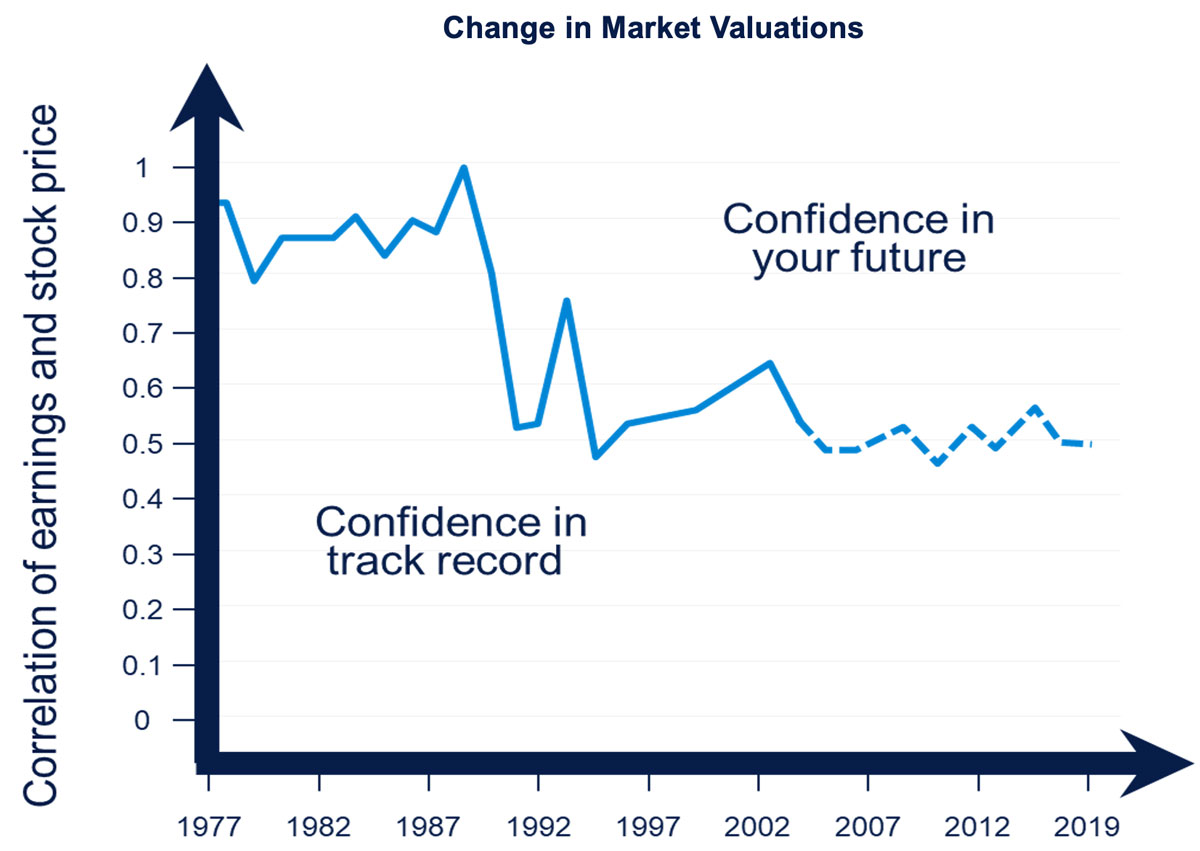How Leaders Build Confidence in the Future
Key Takeaways:
- Even amidst uncertainty, leaders can impact value by managing their intangible assets.
- Architecture for Intangibles provides a framework that enables leaders to build value from intangibles and confidence in future.
- Leaders who manage intangibles and tangibles together tend to have greater success during times of uncertainty by focusing on their capability to deliver value to customers.

How Leaders Build Confidence in the Future

Related Insights
Over the last few months, there has been unprecedented levels of uncertainty about what the future holds. Looking at public markets to see how we’re doing compared to other companies can be confusing without a framework to explain what is happening. Last week S&P earnings were down about 45% while the market stayed the course and even increased a little based on vaccine hopes.
During all of this, executives across industries have talked to us about some common themes:
- Has COVID-19 changed what creates value for our business?
- How do we position ourselves for future success?
- How do we continue to engage our customers and our employees in our future?
These are important questions and can be better understood if we take a step back and look at some trends that have been developing over the last 30 years.
Research by Baruch Lev and others shows that, in today’s financial markets, earnings account for about 50% of a company’s market value. The other 50% comes from the firm’s “intangibles,” a catch-all category of factors not directly related to physical assets which create confidence in the future:

Little wonder that CEOs and CFOs are increasingly frustrated. Under constant pressure to increase their company’s market value, they find themselves grappling with a set of variables whose very name—intangibles—suggests they can’t be defined, much less managed.
Now for the good news: Leaders can have enormous impact on the value created by their companies’ intangible assets. In our work with executive teams, we’ve seen organizations steadily increase their market capitalization by applying what we call the Architecture for Intangibles (see Figure 1). While it’s based on research from a number of studies and from our personal experience, it isn’t a quick fix; the framework’s four steps require discipline, consistency, and sustained focus over time. The benefit, however, is a shared commitment by leaders at all organizational levels to build and protect intangible value.

Figure 1: Architecture for Intangibles
Step 1: Keep Your Promises
The foundation of intangible value is trust. For publicly traded companies, this starts with keeping promises made to the investment community (and other stakeholders). Accurate forecasts and reliable quarterly earnings are the “table stakes” for getting into the intangibles game. During the pandemic this may be very difficult, but clear communication about where the business really stands is essential. Keeping promises extends to meeting customer expectations for service, quality, and delivery, and it includes following through on commitments to employees. Leaders who make and keep promises build credibility, confidence, and conviction.
Avoid dramatic gestures. One high-profile leader boldly and publicly stated her “2020” vision: 20% revenue growth and 20% increase in profits. The firm delivered 15/8--among the best in its industry but below the expectations she had set. The firm’s market value fell, leading to another betrayal of trust and erosion of confidence in the senior management team, ultimately resulting in her resignation. Years later, the company is just beginning to recover its reputation.
Trust is easier to maintain than regain by using the following tips:
- Promise less, deliver more. Unrealistic aspirations create enthusiasm in the short term and cynicism thereafter. Find the balance between optimism and self-deception; insist on a frank and rigorous examination of market and organization realities.
- Be humble in public, confident in private. Share public credit for successes and take responsibility for failures. With employees, express absolute faith that they can and will succeed.
- Start small. In conversations with employees in his first 90 days, a new HR manager kept hearing complaints about the travel reimbursement policy. While not a major economic issue, it had become a symbol of managerial inattention. A simple policy change immediately gained workers’ trust.
- Anticipate and update. Even conservative forecasts are subject to surprises. Inform investors of “new promises” before the grapevine takes over. Don’t hide or defend your mistakes; show that you’ve learned and are moving forward.
Step 2: Create a Clear and Compelling Strategy
NuSkin started business focused on skin care and delivered premium products through their distribution channels. As they grew, they broadened their focus to a clear and compelling strategy about solutions to anti-aging. They now have a broad portfolio of products— including vitamins, skin care and nutrition—all aimed at customers who want to feel and look young and healthy.
This clear focus on who their targeted customers are and what products are most impactful provides customers and investors confidence in the organization’s future—which is a key driver of intangible value.
Consider these ideas for action:
- Get beyond analysis. We sat in a meeting where a well-known consulting firm presented the results of a thorough (and pricey) strategic analysis. The data were detailed and thought-provoking. After two hours, the consultants sat down. We asked the executives in the room, “So, what’s your strategy?” No one could answer. Analysis is a precursor to strategy, not the end product.
- Prioritize. We often ask executive teams to divide 20 points across the three growth strategies (customer intimacy, product/service innovation, or technology/process), with 10 points going to one of the three. No company can be all things to all customers. Focus and prioritize—then invest accordingly.
- Capture the strategy with a story. Stories are found in language (Coke’s “share of stomach”), images (Nike’s swoosh), and heroes (Marriott’s celebration of associates who go “above and beyond” for guests). If the story is compelling enough to galvanize all stakeholders, it adds enormous intangible value.
- Translate the story into action. Not long ago, we worked with a VP-GM who had articulated a compelling strategy: leverage the firm’s technology to continually generate 50% of revenues from products introduced the previous year. When we asked him how he was going to make this happen, he pointed to a stack of committee reports and notebooks full of suggestions for product innovation. Instead, we helped him identify three high-profile decisions he needed to make in the next 30 days to push innovation forward.
Step 3: Align Core Technical Capabilities
Recently we worked with a global manufacturing company that articulated a new strategy to their market. Rather than sell specific equipment, they wanted to focus on their customer’s needs and fulfill a broader suite of solutions. Unfortunately, efforts to execute the new strategy were met with mediocre performance. We identified the core technical capabilities for the previous strategy as well as the “new” core technical capabilities for the future strategy. Leaders continued to deliver the “old” strategy regardless of rubric about the importance of the new strategy. Analysis revealed that the maxim, “we are perfectly organized for the results we have” was true. The new core technical capabilities were spread across the functions and no one was managing them to deliver value to the customers. It was necessary to reorganize the business to enable the new core technical capabilities. Once that occurred it was possible to begin to deliver different results for customers. Technical capabilities include more than scientific and engineering know-how; they are the critical few physical work processes that differentiate an organization’s products and services. As illustrated by the manufacturing company, such capabilities need to be aligned with strategy (or vice versa); otherwise, the strategy fails, and customers and investors lose confidence.
Rate your organization’s alignment in the following areas:
- Do you know what your organization’s growth strategy and core technical capabilities are?
- Do you invest above industry-average levels in the areas that are central to your strategy?
- Do you reduce investments in functions that are overresourced, where the goal should be nothing more than industry parity?
- Do you manage the “core work” of your organization differently from supporting functional work? In core areas, managers should be developed and rewarded for their ability to build competitive advantage. Managers in non-core areas should be held accountable for ensuring cost efficiencies.
Step 4: Enable Cultural Capabilities
Cultural capabilities represent the ways an organization applies people and processes to the tasks of competition. In contrast to the core technical capabilities mentioned in Step 3, cultural capabilities are the “social” capabilities that essentially become the organization’s identity. They define what it is good at doing and are huge drivers of intangible value because they are almost impossible for competitors to imitate.
Here are seven of the basic capabilities an organization can cultivate and examples of companies that have done so:
- Talent: Attracting, motivating, and retaining competent and committed people. Example: Google.
- Speed: Making important changes happen fast. Example: FedEx.
- Customer Connectivity: Ensuring that customers and employees have positive images of and experiences with our organization. Example: Singapore Airlines.
- Accountability: Maintaining the discipline that results in high performance. Example: PepsiCo.
- Collaboration: Working to make the whole more than the parts through both efficiency and leverage. Example: Toyota.
- Learning: Generating ideas with impact, then generalizing them across the organization. Example: Bain & Co.
- Leadership: Embedding branded leaders throughout the organization who deliver the right results in the right way. Example: IBM.
Auditing Your Firm’s Intangibles
Let’s return now to the executives we have talked to during COVID-19 who are worried about the future and their market value going forward. In order to start building intangible value, we suggest that leaders conduct an “intangibles audit.” Just as financial audits allow leaders to monitor cash flow, intangibles audits help leaders to identify how to have the greatest impact on the intangible side of market valuation. The audit should measure how well intangibles are being defined and delivered, leading to an action plan for improving specific practices. Information for the audit is provided by stakeholders internally (executives and employees) and externally (analysts, targeted customers, regulators, and suppliers).
Building Strong Organizations
The Architecture for Intangibles provides a way for leaders to actively manage intangible assets so that they create confidence in the future. As such, it demystifies the valuation process and puts senior leaders more in control. By keeping promises, creating strategies that energize growth, aligning core technical capabilities, and building distinctive cultural capabilities, executives can have tremendous impact on the market value of their respective companies. By making intangibles tangible, leaders can build strong organizations that delight customers, investors, and employees.
Explore how to put these concepts into practice, or contact us to get started.


